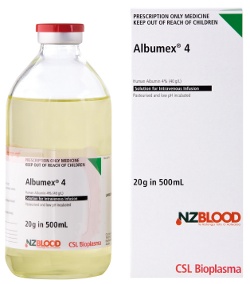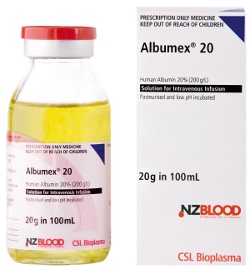Presentation
- Albumex is prepared in two strengths
- Albumex® 4 which is isotonic with blood. This is used for volume expansion, cardiac bypass and plasma exchange. Albumex® 4 bottles are either 50mL (2g) or 500 mL (20g).
- Albumex® 20 (10mL or 100mL) which is hyperoncotic and is used to replace albumen in hypoproteinaemic patients (eg burns, sepsis, ascites). Albumex® 20 bottles are either 10mL (2g) or 100mL (20g). (Albumex® 20 is also known by the older name of salt-poor albumin.)


ABO Compatibility
- Compatibility is not relevant for manufactured (fractionated) plasma product transfusion
- Hypotension has been reported in patients who are also on ACE inhibitors
Storage and Infusion
- May be stored at room temperature but a blood or vaccine fridge is preferred. 10mL Albumex® 20 vials must be stored at 2-8°C
- It is preferable to allow the bottle to come to room temperature before infusing.
- Use a vented infusion set or a standard (or blood) infusion set with a venting spike. No filters are needed.
- Ensure the bottle is designated for the patient being transfused.
- If using from an emergency stock, ensure Blood Bank are informed of the patient and batch numbers transfused
Precautions
- Read manufacturer's instructions carefully
- Always observe for turbidity, floating material and sediment
- Pumps acceptable for use.
Rate
- Complete the infusion within 4 hours of spiking the bottle.
- Monitor rate/volume closely
- For volume expansion/resuscitation, Albumex® 4 may be administered as a rapid infusion to restore perfusion / blood pressure.
- As Albumex® 20 is hyperoncotic, it increases volume by four times by drawing fluid from the extravascular spaces into the vascular system. Administer slowly and carefully. Monitor for signs of volume overload.
- See under Dose for rates for some specific indications.
Monitoring
- It is recommended that blood pressure is monitored regularly during administration.
- Myocardial function should also be monitored e.g. central venous pressure, arterial pressure and pulse rate.
- To avoid circulatory overload the rate and volume of infusion should be monitored frequently.
- Hypokalaemia, thrombocytopenia and prolonged prothrombin times may be worsened with Albumex infusions and should also be monitored.
- Recipients should remain under observation for 20 minutes following administration.
DO NOT
- DO NOT add medications to blood products.
Dose
(adult)
- Albumex® 4 in resuscitation: In an average adult, hypovolaemic shock usually requires at least 1L Albumex® 4. The total volume required cannot be accurately predicted, since it depends on a number of factors. NB: Monitor infusion and patient (eg CVP, BP, pulse) carefully to avoid circulatory overload.
- Albumex® 20 in the acutely ill with hypoproteinaemia: The usual adult daily dose is 250-375mL Albumex® 20 (equivalent to 50-75g albumin). The rate of administration should not exceed 2 mL/min. More rapid infusion may precipitate circulatory overload and pulmonary oedema. NB: Albumex® 20 is hyperoncotic. Monitor infusion and patient (eg CVP, BP, pulse) carefully to avoid circulatory overload.
- Albumex® 20 in burns: The usual adult dose is 20-80g given daily at the rate of about 1mL/min.
- Albumex® 20 in adult respiratory distress: Commence with a dose of 250ml Albumex® 20 (equivalent to 50g albumin) over the first 24 hours together with diuretic therapy. Thereafter adjust dose according to vital signs and plasma albumin concentration.
- Albumex® 20 in haemodialysis: Adults with significant fluid overload may benefit from the administration of 100-200mL of Albumex® 20 at the end of the dialysis procedure.
- Albumex® 20 in paracentesis: infuse 8g /liter of ascites removed after completing paracentesis of more than 5 litres.
Dose
(paediatric)
- Albumex® 4 in resuscitation: In children, hypovolaemic shock the recommended dose is 10-20mL/kg Albumex® 4. The total volume required cannot be accurately predicted, since it depends on a number of factors. NB: Monitor infusion and patient (eg CVP, BP, pulse) carefully to avoid circulatory overload.
- Albumex® 20 in the acutely ill with hypoproteinaemia: In children the recommended dose is 2.5-5mL/kg Albumex® 20 (equivalent to 0.5-1g/kg albumin), administered over 2-3 hours. More rapid infusion may precipitate circulatory overload and pulmonary oedema. NB: Albumex® 20 is hyperoncotic. Monitor infusion and patient (eg CVP, BP, pulse) carefully to avoid circulatory overload.
More Info